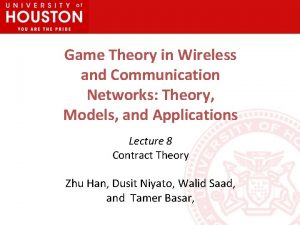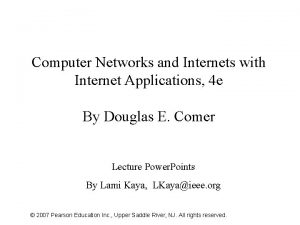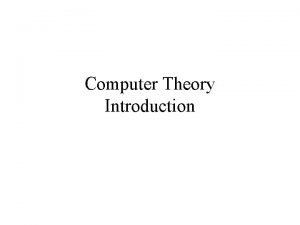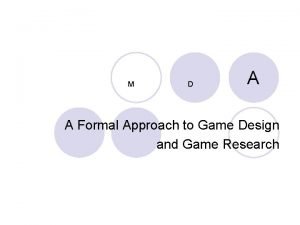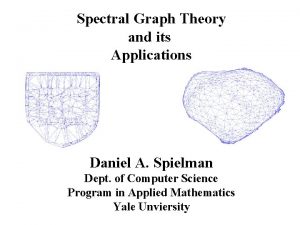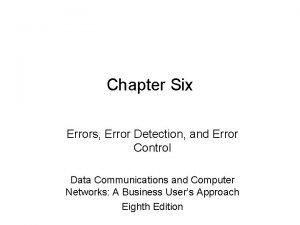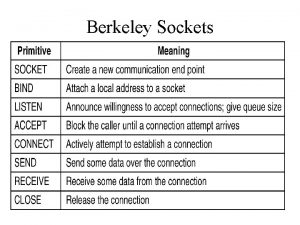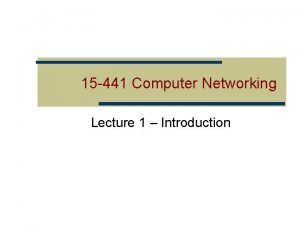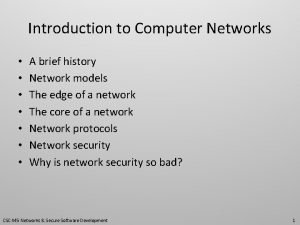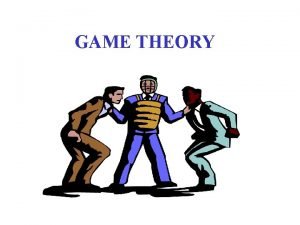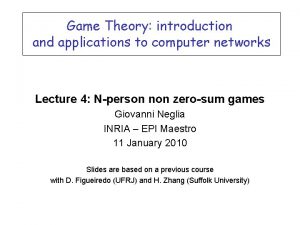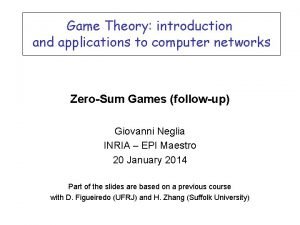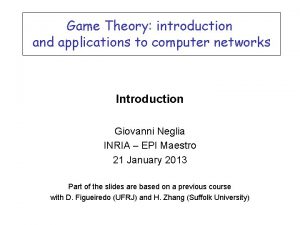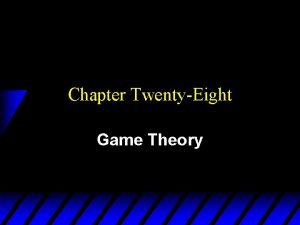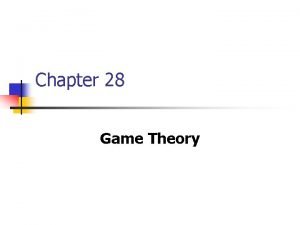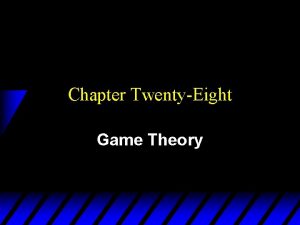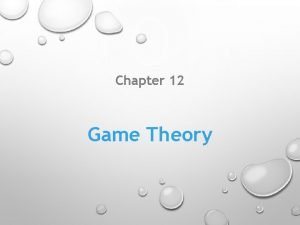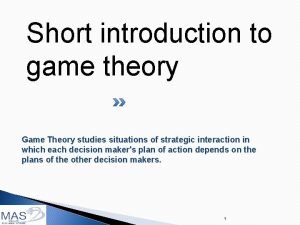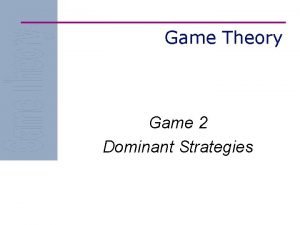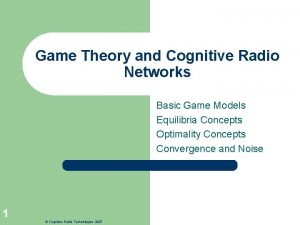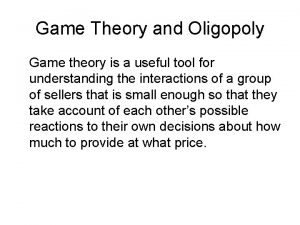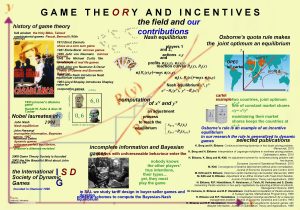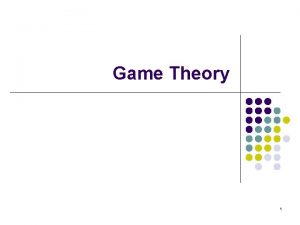Game Theory introduction and applications to computer networks




































































- Slides: 68

Game Theory: introduction and applications to computer networks Lecture 1: introduction Giovanni Neglia INRIA – EPI Maestro 9 December 2009 Slides are based on a previous course with D. Figueiredo (UFRJ) and H. Zhang (Suffolk University)

What is Game Theory About? r Mathematical/Logical analysis of situations of conflict and cooperation 2 2 r Game of Chicken m driver who steers away looses m what should drivers do? r Goal: to prescribe how rational players should act

What is a Game? r A Game consists of m at least two players m a set of strategies for each player m a preference relation over possible outcomes r Player is general entity m individual, company, nation, protocol, animal, etc r Strategies m actions which a player chooses to follow r Outcome m determined by mutual choice of strategies r Preference relation m modeled as utility (payoff) over set of outcomes

Short history of GT r Forerunners: m Waldegrave’s first minimax mixed strategy solution to a 2 -person game (1713), Cournot’s duopoly (1838), Zermelo’s theorem on chess (1913), Borel’s minimax solution for 2 -person games with 3 or 5 strategies (20 s) r 1928: von Neumann’s theorem on two-person zero-sum games r 1944: von Neumann and Morgenstern, Theory of Games and Economic r r r Behaviour 1950 -53: Nash’s contributions (Nash equilibrium, bargaining theory) 1952 -53: Shapley and Gillies’ core (basic concept in cooperative GT) 60 s: Aumann’s extends cooperative GT to non-transferable utility games 1967 -68: Harsanyi’s theory of games of incomplete information 1972: Maynard Smith’s concept of an Evolutionarily Stable Strategy Nobel prizes in economics m m 1994 to Nash, Harsanyi and Selten for “their pioneering analysis of equilibria in theory of non-cooperative games” 2005 to Aumann and Schelling “for having enhanced our understanding of conflict and cooperation through game-theory analysis” r Movies: m 2001 “A beautiful mind” on John Nash’s life m www. econ. canterbury. ac. nz/personal_pages/paul_walker/gt/hist. htm r See also:

Applications of Game Theory r Economy r Politics (vote, coalitions) r Biology (Darwin’s principle, evolutionary GT) r Anthropology r War r Management-labor arbitration r Philosophy (morality and free will) r National Football league draft

Applications of Game Theory r “Recently” applied to computer networks m Nagle, RFC 970, 1985 • “datagram networks as a multi-player game” m wider interest starting around 2000 r Which are the strategies available? m Network elements follow protocol!!!

Power games

Medium Access Control Games

Medium Access Control Games r Despite of the Wi-Fi certification, several cards exhibit very heterogeneous performance, due to arbitrary protocol implementations m “Experimental Assessment of the Backoff Behavior of Commercial IEEE 802. 11 b Network Cards, ” G Bianchi et al, INFOCOM 2007

Routing games Delay 2 ? 2 2 2 1 2 2 r Possible in the Internet? 2 Traffic

Overlay networks Overlay Internet Underlay

Routing games 1 3 4 underlay route 2 1 3 4 route allowed by the overlay r Users can ignore ISP choices An Overlay for routing: Resilient Overlay Routing

Free riders in P 2 P networks r Individuals not willing to pay the cost of a public good, they hope that someone else will bear the cost instead r Few servers become the hot spots: Anonymous? , Copyright? , Privacy? Scalability? , Is it P 2 P?

Connection games in P 2 P q Each peer may open multiple TCP connections to increase its downloading rate

Diffusion of Bit. Torrent variants r Try to exploit Bit. Torrent clients weaknesses Bit. Thief r Are they really dangerous? m Evolutionary game theory says that Yes they can be

Space for GT in Networks r User behaviors (to share or not to share) m Client variants r Protocols do not specify everything… m power level to use m number of connections to open r …and/or are not easy to enforce m how control a P 2 P network m not-compliant Wi. Fi implementation r …and software easy to modify

Limitations of Game Theory r Real-world conflicts are complex m models can at best capture important aspects r Players are considered rational m determine what is best for them given that others are doing the same m Men are not, but computers are more r No unique prescription m not clear what players should do r But it can provide intuitions, suggestions and partial prescriptions m the best mathematical tool we have

Outline r Following “Straffin, Game Theory and Strategy”: r Two-person zero-sum games m Matrix games • Pure strategy equilibria (dominance and saddle points), ch 2 • Mixed strategy equilibria, ch 3 m m Game trees, ch 7 About utility, ch 9 r Two-person non-zero-sum games m Nash equilibria… • …And its limits (equivalence, interchangeability, Prisoner’s dilemma), ch. 11 and 12 m m Strategic games, ch. 14 Evolutionary games, ch. 15 r N-persons games

Game Theory: introduction and applications to computer networks Lecture 1: two-person zero-sum games Giovanni Neglia INRIA – EPI Maestro 9 December 2009 Slides are based on a previous course with D. Figueiredo (UFRJ) and H. Zhang (Suffolk University)

Matrix Game (Normal form) Player 2, Colin Strategy set for Player 1, Rose Strategy set for Player 2 A B C A (2, 2) (0, 0) (-2, -1) B (-5, 1) (3, 4) (3, -1) Payoff to Player 1 Payoff to Player 2 r Simultaneous play m players analyze the game and then write their strategy on a piece of paper

More Formal Game Definition r Normal form (strategic) game ma finite set N of players m a set strategies Si for each player m payoff function for each player • where • sometimes also • is an outcome

Two-person Zero-sum Games r One of the first games studied m most well understood type of game r Players interest are strictly opposed m what one player gains the other loses m game matrix has single entry (gain to player 1) r A “strong” solution concept

Let’s play! Colin Rose A B C D A 12 -1 1 0 B 5 1 7 -20 C 3 2 4 3 D -16 0 0 16 r Divide in pairs, assign roles (Rose/Colin) and play 20 times r Log how many times you have played each strategy and how much you have won

Analyzing the Game Colin Rose A B C D A 12 -1 1 0 B 5 1 7 -20 C 3 2 4 3 D -16 0 0 16 dominated strategy (dominated by B)

Dominance r Strategy S (weakly) dominates a strategy T if every possible outcome when S is chosen is at least as good as corresponding outcome in T, and one is strictly better m. S strictly dominates T if every possible outcome when S is chosen is strictly better than corresponding outcome in T r Dominance Principle m rational players never choose dominated strategies r Higher Order Dominance Principle m iteratively remove dominated strategies

Higher order dominance may be enough Colin Rose A B C D A 12 -1 1 0 B 3 1 4 -18 C 5 2 4 3 D -16 0 5 -1

Higher order dominance may be enough GT prescribes: Rose C – Colin B Rose (Weakly) Dominated by C Colin A B C D A 12 -1 1 0 B 3 1 4 -18 C 5 2 4 3 D -16 0 5 -1 A priori D is not dominated by C Strictly dominated by B

… but not in the first game Colin Rose A B C D A 12 -1 1 0 B 5 1 7 -20 C 3 2 4 3 D -16 0 0 16 dominated strategy (dominated by B)

Analyzing the Reduced Game: Movement Diagram Colin Rose A B D A 12 -1 0 B 5 1 -20 C 3 2 3 D -16 0 16 Outcome (C, B) is “stable” m m saddle point of game mutual best responses

Saddle Points r An outcome (x, y) is a saddle point if the corresponding entry u(x, y) is both less than or equal to any value in its row and greater than or equal to any value in its column m u(x, y) <= u(x, w) for all w in S 2=SColin m u(x, y) >= u(v, y) for all v in S 1=SRose A B C A 12 5 3 B -1 1 2 D 0 -20 3 D -16 0 16

Saddle Points Principle r Players should choose outcomes that are saddle points of the game m Because it is an equilibrium… m … but not only

Saddle Points main theorem r The game has a saddle point iff maxv minw u(v, w) = minw maxv u(v, w) Rose Colin A B D minw A 12 -1 0 -1 B 5 1 -20 C 3 2 D -16 0 16 -16 maxv 12 2 16 • Rose C ε argmax minw u(v, w) most cautious strategy for Rose: it secures the maximum worst case gain independently from Colin’s action (the game maximin value) • Colin B ε argmin maxv u(v, w) most cautious strategy for Colin: it secures the minimum worst case loss (the game minimax value)

Saddle Points main theorem r Another formulation: m The game has a saddle point iff maximin = minimax, r This value is called the value of the game

Saddle Points main theorem r The game has a saddle point iff maxv minw u(v, w) = minw maxv u(v, w) N. C. Two preliminary remarks 1. It holds (always) maxv minw u(v, w) <= minw maxv u(v, w) because minwu(v, w)<=maxvu(v, w) for all v and w r By definition, if (x, y) is a saddle point m u(x, y)<=u(x, w) for all w in SColin • i. e. u(x, y)=minw u(x, w) m u(x, y) >= u(v, y) for all v in SRose

Saddle Points main theorem r The game has a saddle point iff maxv minw u(v, w) = minw maxv u(v, w) maxv minw u(v, w) <= minw maxv u(v, w) 2. if (x, y) is a saddle point 1. N. C. o u(x, y)=minw u(x, w), u(x, y)=maxv u(v, y) u(x, y)=minwu(x, w)<=maxvminwu(v, w)<=minwmaxvu(v, w)<=maxvu(v, y)=u(x, y)

Saddle Points main theorem r The game has a saddle point iff maxv minw u(v, w) = minw maxv u(v, w) x in argmax minw u(v, w) y in argmin maxv u(v, w) We prove that (x, y) is a saddle-point v 0 w 0 in argminw u(x, w) (maxvminwu(v, w)=u(x, w 0)) v 0 in argmaxv u(v, y) (minwmaxvu(v, w)=u(v 0, y)) x u(x, w 0)=minwu(x, w)<=u(x, y)<=maxvu(v, y)=u(v 0, y) Note that u(x, y) = maxv minw u(v, w) w 0 y <= S. C. <=

Saddle Points main theorem r The game has a saddle point iff maxv minw u(v, w) = minw maxv u(v, w) Rose Colin A B D minw A 12 -1 0 -1 B 5 1 -20 C 3 2 D -16 0 16 -16 maxv 12 2 16 This result provides also another way to find saddle points

Properties r Given two saddle points (x 1, y 1) and (x 2, y 2), m they have the same payoff (equivalence property): • it follows from previous proof: u(x 1, y 1) = maxv minw u(v, w) = u(x 2, y 2) m (x 1, y 2) and (x 2, y 1) are also saddle points(interchangeability property): y 1 y 2 • as in previous proof <= They make saddle point a very nice solution! x 2 x 1 <=

What is left? r There are games with no saddle-point! r An example? R P S min R 0 -1 1 -1 P 1 0 -1 -1 S -1 1 0 -1 max 1 1 1 minimax maximin <> minimax

What is left? r There are games with no saddle-point! r An example? An even simpler one A B min A 2 0 0 B -5 3 -5 max 2 3 minimax maximin

Some practice: find all the saddle points A B C A -2 0 4 0 B 2 1 3 2 C 3 -1 -2 A B C D A 3 2 4 2 B 2 1 3 C 2 2 2 A B C A 4 3 8 B 9 5 1 C 2 7 6

Games with no saddle points Rose Colin A B A 2 0 B -5 3 r What should players do? m resort to randomness to select strategies

Mixed Strategies r Each player associates a probability distribution over its set of strategies r Expected value principle: maximize the expected payoff Colin Rose A B 1/3 A 2 -5 2/3 B 0 3 Rose’s expected payoff when playing A = 1/3*2+2/3*0=2/3 Rose’s expected payoff when playing B = 1/3*-5+2/3*3=1/3 r How should Colin choose its prob. distribution?

Rose 2 x 2 game A B Colin p A 2 -5 Rose’s expected payoff 3 1 -p B 0 3 2 0 -5 0 3/10 1 p Rose’s exp. gain when playing A = 2 p + (1 -p)*0 = 2 p Rose’s exp. gain when playing B = -5*p + (1 -p)*3 = 3 -8 p r How should Colin choose its prob. distribution? o Rose cannot take advantage of p=3/10 o for p=3/10 Colin guarantees a loss of 3/5, what about Rose’s?

2 x 2 game Colin’s expected loss Rose 1 -q q Colin A B A 2 -5 3 B 0 3 2 0 -5 0 8/10 1 q Colin’s exp. loss when playing A = 2 q -5*(1 -q) = 7 q-5 Colin’s exp. loss when playing B = 0*q+3*(1 -q) = 3 -3 q r How should Rose choose its prob. distribution? o Colin cannot take advantage of q=8/10 o for q=8/10 Rose guarantees a gain of?

1 -q q Rose 2 x 2 game A B Colin p A 2 -5 Rose’s expected payoff 3 1 -p B 0 3 Colin’s expected loss 3 2 2 0 0 -5 -5 0 3/10 1 p 0 8/10 1 r Rose playing the mixed strategy (8/10, 2/10) and Colin playing the mixed strategy (3/10, 7/10) is the equilibrium of the game o No player has any incentives to change, because any other choice would allow the opponent to gain more o Rose gain 3/5 and Colin loses 3/5 q

Rose 1 -x-y y x mx 2 game A B C Colin p A 2 -5 3 Rose’s expected 3 payoff 3 1 -p B 0 3 -5 2 0 -5 -5 0 3/10 1 p r By playing p=3/10, Colin guarantees max exp. loss = 3/5 o it loses 3/5 if Rose plays A or B, it wins 13/5 if Rose plays C r Rose should not play strategy C

Rose 1 -x-y y x mx 2 game A B C Colin p A 2 -5 3 Colin’s expected loss 1 -p B 0 3 -5 (8/10, 2/10, 3/5) r Then Rose should play 3 0 1 mixed x strategy(8/10, 2/10, 0) r guaranteeing a gain not less than 3/5 -5 1 y

Minimax Theorem r Every two-person zero-sum game has a solution, i. e, there is a unique value v (value of the game) and there are optimal (pure or mixed) strategies such that m Rose’s optimal strategy guarantees to her a payoff >= v (no matter what Colin does) m Colin’s optimal strategies guarantees to him a payoff <= v (no matter what Rose does) r This solution can always be found as the solution of a kxk subgame r Proved by John von Neumann in 1928! m birth of game theory…

How to solve mxn matrix games 1. Eliminate dominated strategies 2. Look for saddle points (solution of 1 x 1 games), if found stop 3. Look for a solution of all the hxh games, with h=min{m, n}, if found stop 4. Look for a solution of all the (h-1)x(h-1) games, if found stop 5. … h+1. Look for a solution of all the 2 x 2 games, if found stop

How to solve mxm games r if all the strategies are used at the equilibrium, the probability vector is such to make equivalent for the opponent all its strategies a linear system with m-1 equations and m-1 variables if it has no solution, then we need to look for smaller subgames m m Rose 1 -x-y y x A Colin B C A 2 0 1 B -5 3 -2 C 3 -5 3 Example: m m 2 x-5 y+3(1 -x-y)=0 x+3 y-5(1 -x-y) 2 x-5 y+3(1 -x-y)=1 x-2 y+3(1 -x-y)

How to solve 2 x 2 games Rose 1 -q q r If the game has no saddle point m calculate the absolute difference of the payoffs achievable with a strategy m invert them m normalize the values so that they become probabilities A B Colin p A 2 -5 1 -p B 0 3 |2 -0|=2 8 8/10 |-5 -3|=8 2 2/10

Utility: where do numbers come from? r Only in some (simple) cases a natural quantitative metric r Utility theory: how to assign numbers to payoffs so that they reflect player’s preferences r For saddle points: only ordinal utilities are needed m consistency conditions for player’s preferences: player has to be able to rank outcomes r in general cardinal utilities are needed m ratio of differences is meaningful m affine transformations do not change the game • summing a constant value to all the payoffs • multiplying all the payoffs for the same value

How to determine cardinal utilities (Von Neumann and Morgenstern) r let player rank outcomes, e. g. a < b < c < d r assign arbitrary numerical utilities to the least and the most preferred, e. g. a=0, d=100 r determine the utilities of the other outcomes by asking the player to compare lotteries “do you prefer b to a lottery where you can win d with probability p and a with probability 1 -p? ” m when the equivalent lott. is determined (with prob. pe) assign to b the lottery expected value, i. e. 100*pe m r more sophisticated consistency conditions are required

Utilities: remarks on zero-sum games r For the game to be zero-sum the other player has to express exactly reverse preferences r but cardinal utilities are to some extent arbitrary o payoff affine transformations do not change the result => “masked” zero-sum games o how to recognize them it exists i, j, h, k | i*u. R+j+h*u. C+k=0, => (u. R, u. C) lie on a segment Rose Colin A B A (2, -2) (0, 0) B (-5, 5) (3, -3) u’C=3*u. C+6 Rose • Colin A A B (2, 0) B (0, 6) (-5, 21) (3, -3)

Game Trees (Extensive form) r Sequential play m players take turns in making choices m previous choices may be available to players r Game represented as a tree m each non-leaf node represents a decision point for some player m edges represent available choices

Game Trees: simplified poker r Rose and Colin put 1$ each in the pot and take a card (Ace or King) r Colin may bet other 2$ or drop r If Colin bets m Rose can put other 2$ and call (and the highest card wins) m or can fold (and Colin takes the money) r If Colin drops m Rose takes all the money in the pot

Tree of the simplified poker Chance A, A 1/4 Rose drop (1, -1) bet Rose K, A 1/4 Colin bet A, K 1/4 K, K 1/4 drop (1, -1) bet Rose call fold (0, 0) (-1, 1) (3, -3) (-1, 1) (-3, 3) (-1, 1) Colin drop (1, -1) bet drop Rose call fold (1, -1) (0, 0) (-1, 1) Arc joins states of a player in the same information set: • when playing the player cannot distinguish these states -the known sequence of past events is the same -the set of future actions is the same

Game trees: more formal definition 1. 2. 3. 4. 5. each node is labeled by the player (including Chance) who makes a choice at that node each branch leading by a node corresponds to a possible choice of the player at the node each branch corresponding to a choice made by Chance is labeled with the corresponding probability each leaf is labeled by players payoffs nodes of each player are partitioned in information sets

Game trees and matrix games r Each game tree can be converted in a matrix game! r Connecting idea: strategy in game tree m it specifies a priori all the choices of the player in each situation • only need to specify for each information set m e. g. in simplified poker • for Colin 4 possible strategies – “always bet” (bb), “bet only if ace” (bd), “bet only if king” (db), “always drop” (dd) • for Rose 4 possible strategies – “always call” (cc), “call only if ace” (cf), “call only if king” (fc), “always fold” (ff)

Game trees and matrix games r Each game tree can be converted in a matrix game! r Once identified the strategies of every player… r …use the expected payoffs of the game tree as payoffs of the matrix game

Game trees and matrix games A, A 1/4 Colin bet Rose drop (1, -1) callfold (0, 0) (-1, 1) Colin bet Rose callfold (3, -3)(-1, 1) Chance A, K 1/4 drop (1, -1) K, A 1/4 Colin bet Rose K, K 1/4 drop Colin bet drop (1, -1)Rose (1, -1) callfold (0, 0)(-1, 1) (-3, 3)(-1, 1) Rose Colin bb bd db dd cc 0 -1/4 5/4 1 cf 1/4 1 1 fc -5/4 -1/2 1/4 1 0 1 ff -1 0 Study this game

Game trees and matrix games r Each game tree can be converted in a matrix game! r Problem: this approach does not scale with the size of the tree m exponential growth in the number of strategies • consider how many strategies are available in chess to White and to Black for their respective first move r Try to study directly the game tree

Game trees with perfect information r Definition 1. no nodes are labeled by Chance 2. all information sets consist of a single node r Test: which among the following is a game with perfect information and why? m poker m tic, tac, toe m rock, scissor, paper • honestly and dishonestly played… m chess m guess the number

Perfect information: an example Player 1 R L Player 2 Payoff to Player 1 L R 3, -3 0, 0 -2, 2 1, -1 r Strategy sets m for Player 1: {L, R} m for Player 2: {LL, LR, RL, RR} r Convert it to a matrix game and solve it Payoff to Player 2

Converting to Matrix Game L Player 2 Player 1 R L R 3, -3 0, 0 -2, 2 1, -1 LL LR RL RR L 3 3 0 0 R -2 1

Solving the game by backward induction r Starting from terminal nodes m move up game tree making best choice L R L R 3, -3 0, 0 -2, 2 1, -1 Equilibrium outcome L 0, 0 r Saddle point: R -2, 2 P 1 chooses L, P 2 chooses RL Best strategy for P 2: RL Best strategy for P 1: L

Kuhn’s Theorem r Backward induction always leads to saddle point (on games with perfect information) m game value at equilibrium is unique (for zero-sum) r Consequences for chess? m at the saddle point • • • or White wins, value = 1 -> White has winning strategy no matter what Black does or Black wins, value = -1 -> Black has winning strategy, no matter what White does or they draw, value = 0 -> Both White and Black have a strategy guaranteeing at least drawing Chess is a simple game! (Zermelo 1913)
 Datagram network diagram
Datagram network diagram Computer networks and internets with internet applications
Computer networks and internets with internet applications Backbone networks in computer networks
Backbone networks in computer networks Uses of computer in business
Uses of computer in business Principles of network applications
Principles of network applications Business applications of computer networks
Business applications of computer networks Business application in computer network
Business application in computer network Game theory in wireless and communication networks
Game theory in wireless and communication networks Clemson canvs
Clemson canvs Pirate game sheet
Pirate game sheet Game lab game theory
Game lab game theory Liar game game theory
Liar game game theory Liar game game theory
Liar game game theory Game theory and graph theory
Game theory and graph theory Image sets
Image sets Diffserv vs intserv
Diffserv vs intserv Error detection in computer networks
Error detection in computer networks Bit stuffing and byte stuffing
Bit stuffing and byte stuffing Byte stuffing and bit stuffing
Byte stuffing and bit stuffing Reverse arp
Reverse arp Analogue and digital transmission in computer networks
Analogue and digital transmission in computer networks Http computer networks
Http computer networks What is crc in computer network
What is crc in computer network Protocols and standards in computer networks
Protocols and standards in computer networks Error detection and correction in computer networks
Error detection and correction in computer networks Computer networks and internets
Computer networks and internets Introduction to computer theory
Introduction to computer theory Nhpce
Nhpce A formal approach to game design and game research
A formal approach to game design and game research Daniel spielman spectral graph theory
Daniel spielman spectral graph theory Spectral graph theory and its applications
Spectral graph theory and its applications Managerial economics: theory, applications, and cases
Managerial economics: theory, applications, and cases Crc in computer networks
Crc in computer networks Crc in computer networks
Crc in computer networks Traffic management in computer networks
Traffic management in computer networks Speed of a computer
Speed of a computer What is optimality principle in computer networks
What is optimality principle in computer networks Snmp osi model
Snmp osi model What is optimality principle in computer networks
What is optimality principle in computer networks Classify computer networks based of transmission technology
Classify computer networks based of transmission technology Intro dns
Intro dns Icmp in computer networks
Icmp in computer networks Framing in computer network
Framing in computer network Dns in computer networks
Dns in computer networks Data communication and networking assignment questions
Data communication and networking assignment questions Computer networks vs distributed systems
Computer networks vs distributed systems Algorithms in computer networks
Algorithms in computer networks Internet transport protocol in computer networks
Internet transport protocol in computer networks Error control in computer networks
Error control in computer networks What is optimality principle in computer networks
What is optimality principle in computer networks Data link layer switching
Data link layer switching Layered network architecture
Layered network architecture Byte stuffing in computer networks
Byte stuffing in computer networks Berkeley sockets in computer networks
Berkeley sockets in computer networks In ftp protocol client contacts server using
In ftp protocol client contacts server using Https://speakerdeck.com/
Https://speakerdeck.com/ Cmu computer networks
Cmu computer networks Utopian simplex protocol
Utopian simplex protocol Sonet network
Sonet network Connectionless internetworking
Connectionless internetworking Physical structures in computer networks
Physical structures in computer networks Osi model mnemonic
Osi model mnemonic Network layer design issues
Network layer design issues History of computer network
History of computer network What is fddi
What is fddi Fast ethernet in computer networks
Fast ethernet in computer networks Exponential backoff ethernet
Exponential backoff ethernet Unrestricted simplex protocol
Unrestricted simplex protocol Dns in computer networks
Dns in computer networks







